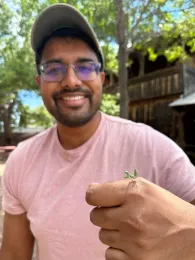Bohart Museum to Host Open House on Praying Mantises

The Bohart Museum of Entomology is hosting an open house, themed "Praying Mantises," on Sunday, Aug. 27 in Room 1124 of the Academic Surge Building, 455 Crocker Lane, UC Davis campus. It is free and family friendly.
When asked what's fascinating about praying mantises, Lohit Garikipati, UC Davis entomology graduate (bachelor of science degree, 2019) wrapping up his master's degree with biologist Christopher Oufiero at Towson University,Towson, MD, said:
"What's fascinating about them... hard to pick just one thing! If I had to choose it would be their general awareness about the environment they are in. They are always watching, always waiting, and adjust their posture, behavior, and movement based on various environmental stimuli. They engage in some of the most interesting predatory behaviors; pouncing, lunging, spearing (yes, spearing!) and sometimes throwing themselves off of perches to secure potential prey. Few flightless predators can catch prey out of the air on the wing but many specialized species are more than capable of doing so. They are the insect equivalent of cats in many ways, but with some weird adaptations!"
Garikipati, who participated in many Bohart Museum open houses while a student at UC Davis, won't be at the open house on Aug. 27 but he will be their spirit. He plans to obtain his doctorate in entomology.
According to Kris Anderson of Las Vegas, an alumnus of Cornell University (master's degree in entomology) and author of Praying Mantises of the United States and Canada: "There are just 28 species of Mantodea found within the United States and Canada, the 7 largest of which are invasive species from other parts of the globe."
Some myths about praying mantises, as related by Anderson in his book, available on Amazon:
Myth: "Mantises sway back and forth while crawling to imitate vegetation blowing in the wind."
Truth: "The peering movement of mantises, demonstrated by the swaying back and forth of their body while ambulating or preparing to leap/take flight, is a behavioral adaptation to gain depth perception of their surroundings and has nothing to do with mimicry. Mantises blend into their environment by remaining motionless against a substrate that they morphologically resemble—not by moving. Peering movements causes the retinal images of nearby objects to be displaced more quickly than those of more distant objects, thus allowing the mantis to gain depth perception of its environment as it navigates forward."
Myth: "Mantises grab insects and immediately bite the neck/head to quickly kill their prey."
Truth: "The spinose forelegs of praying mantises are used to hold onto and prevent their prey from escaping. Once secured in their grip, the mantis will pull the prey forward and begin to meticulously chew upon whatever body part of the prey item is closest to their mouth—be it a leg, a wing, the thorax, abdomen, or head. No specific body region is exclusively targeted and the prey is always eaten alive, bit by bit, dying a slow death."
Myth: "Female mantises cannibalize the males while mating."
Truth: "With over 2,400 species of Mantodea worldwide, only a small fraction of species regularly engage in sexual cannibalism. Most do not. Of those that engage in this practice, the occurrence is not inevitable, as males typically escape and may mate with other partners."
The Bohart Museum, founded in 1946 and directed by UC Davis distinguished professor Lynn Kimsey, houses a global collection of eight million insect specimens, plus a live insect petting zoo (Madagascar hissing cockroaches, stick insects and tarantulas), and an insect-themed gift shop, stocked with t-shirts, hoodies, books, posters, jewelry and more.
The Bohart Museum is planning two other open houses this fall:
Saturday, Sept. 23: Household Vampires
Saturday, Nov. 4: Monarchs
All open houses are free and family friendly. At each event, the focus is on a special theme, but there's also a family arts-and-crafts activity, announced Tabatha Yang, education and outreach coordinator.
